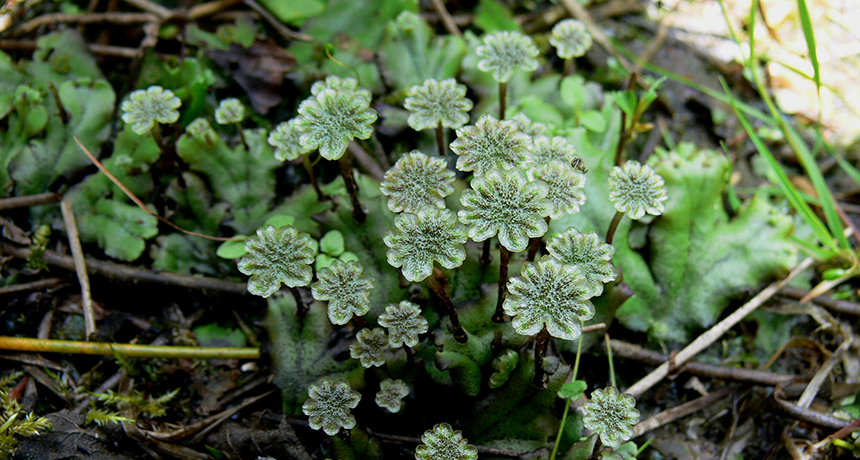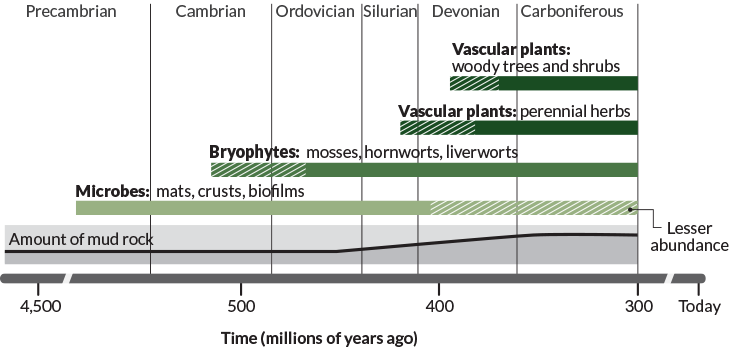
MUD MAKEOVER Before rooted plants appeared on Earth, there were bryophytes, a group including modern mosses and liverworts, such as this Marchantia. New research suggests these early land plants helped shape Earth’s surface by creating clay-rich river deposits.
F. Lamiot/Wikimedia Commons (CC BY-SA 3.0)
- More than 2 years ago
Early plants made Earth muddier. Ancient riverbed deposits of mud rock — rocks containing bits of clay and silt smaller than grains of sand — began increasing around 458 million years ago, around the time that rootless plants became common across Earth, researchers say.
Anecdotally, geologists have long noted that early sediment deposits became muddier at some point, and suggested a connection with plants (SN: 6/22/74, p. 398). But no one had ever pinpointed when that muddening happened.
So geologists William McMahon and Neil Davies, both of the University of Cambridge, decided to look for when amounts of mud rock began increasing in 704 ancient river deposits from 3.5 billion to 300 million years ago. The researchers searched through nearly 1,200 published papers for data on mud rock in river deposits, and collected new field data at 125 ancient river outcrops. At those outcrops, the researchers calculated the percent of mud rock in the overall deposit by measuring the thickness of the muddy layers compared with the thickness of layers containing larger grains such as sand.
The resulting fractions showed the median mud content was about 1 percent before around 458 million years ago. At that point, the mud content steadily increased over about the next 100 million years or so to reach a median of about 26 percent in outcrops dated 359 million to 299 million years old, McMahon and Davies report in the March 2 Science.
That steady upsurge suggests that neither cyclical nor episodic forces — such as glacial-interglacial changes or tectonic events — could have driven the increase in muddiness. Instead, plants are the likeliest culprit. A primitive group of rootless plants called bryophytes, which includes modern mosses and liverworts, had likely become common by about 458 million years ago. Rooted plants further increased the mud content when they arose and began to spread around 430 million years ago, eventually forming great forests about 382 million years ago.
Plant progression
Plants’ evolution and colonization of Earth altered its landscape. The appearance of the earliest land plants coincided with a rise in mud rock starting around 458 million years ago.

That plants like bryophytes influenced the formation of mud deposits long before roots appeared is a surprise, says geobiologist Woodward Fischer of Caltech who wrote a commentary about the study for the same issue of Science. “The plants of that time were tiny little scrappy things,” Fischer says. “They’re closer to green mats.”
Exactly how ancient plants, rooted or not, helped increase Earth’s muddiness is still uncertain. Earth had mud before it had plants: Weathering of rocks can create silt and clay, and microbes and fungi also erode rock material into ever tinier bits. But plants can speed up the production of clays, for example, by secreting organic acids that change soil chemistry.
Plants also likely play a major role in shaping landscapes by altering the distribution of clay and silt. “There’s something the plants are doing that has to do with the construction of floodplain deposits,” Fischer says. Even scrappy little bryophytes can increase how much mud remains on land by inhibiting wind and water from carrying sediment away. As plants evolved, their influence on the landscape became stronger. Some studies have suggested that the appearance of rooted plants altered the flow of rivers by stabilizing riverbanks, he says.
The new research could also help scientists better interpret sediment formations on Mars, where there are no plants. Earth before the rise of bryophytes is more similar to the Red Planet than modern Earth, Davies says. “If you want an analog for Mars, you need to look at a time when Earth was like Mars.”






